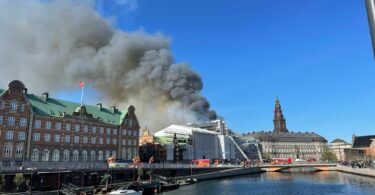
An ofrenda, or altar, in the author’s front yard for El Día de los Muertos. (Regina López/YJI)
Cuautla, Morelos, MEXICO – On the first and second of November, when you walk through the door of my house, there is a 100% probability that you will find a beautiful ofrenda lying in the living room.
This means that you have already gone through the same path my ancient relatives came into the house.
Relax, this is totally normal on the El Día de los Muertos, or Day of Dead, the day where we welcome the dead into our homes. This is the day – or the days, first children then adults – when our loved ones come to visit us just for a night.
For the last 16 years, my mom has built a beautiful ofrenda, a type of altar, with steps made of cardboard, for the holiday. This year, it’s in our front yard.
We decorate the ofrenda with everything that reminds us of our family – pictures, food, clothes and colors. We also put some traditional things like cempasuchil flowers or papel picado, cut with the design of a catrina – a colorful skull that symbolizes the Day of the Dead.
Every year I overwhelm my mom with questions about the people in the pictures. I felt how much they were loved just by the way my mom looks at their pictures. I believe that this day is one of the most cheerful ways to be nostalgic.

Cempasuchil flowers for El Día de los Muertos. (Regina López/YJI)
El Día de los Muertos began with ancient natives like the Náhuatls or the Aztecs, who considered it disrespectful to mourn those who were dead. What better way to pay them respect than by throwing a party?
Every state in Mexico celebrates in a different way.
In Mexico City, where I live, the government throws a big carnival in the streets usually in the Zócalo, a big public plaza, where you can see women dressed as catrinas and men dressed as calaveras, or skulls, dancing to regional music.
In the night there is always a show with singers and dancers or even acrobats.

Outdoor decorations for El Día de los Muertos. (Regina López/YJI)
Now, El Día de los Muertos is the product of every historic event Mexico and its people have been through, including Halloween, but instead of trick-or-treat it is calavera.
This is also a day where all kinds of art flourishes. This date is when the most talented writers create one of the most iconic pieces of literature: la calaverita.
Since I was in elementary school, it was mandatory to write this poem, which is typically a satire about El Día de los Muertos.
Most of the time the poem is about the catrina, the symbol of this day, which was created by artist José Guadalupe Posada.
Today, Posada’s work – originally made to mock the upper class – is the representation of El Día de los Muertos.

A woman selling art for El Día de los Muertos paints a calaver. (Regina López/YJI)
It is difficult to feel alone on this day because this is a holiday that is meant to be celebrated with family. Extra family will come, too. You might not see them, but you might feel their presence.
It’s comforting to think that they are with you again, even if it is just for one night.
Sometimes people forget about the spiritual bit and just have a party. But with the sole act of believing, it fills the space in your heart that has remained since your loved ones left.
But that’s okay. Mexico is a country with a great personality and identifiable traditions, which is why most people here celebrate El Día de los Muertos – just because it’s fun.
Regina López is a Junior Reporter with Youth Journalism International.


